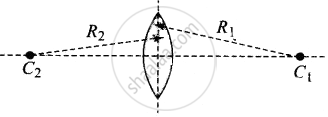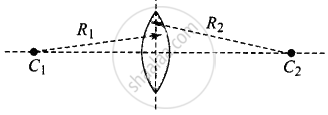Advertisements
Advertisements
प्रश्न
An unsymmetrical double convex thin lens forms the image of a point object on its axis. Will the position of the image change if the lens is reversed?
उत्तर
Thin lens formula: `1/v - 1/u = 1/f`
For a given object position if focal length of the lens does not change, the image position remains unchanged.
By lens maker's formula,
`1/f = (mu - 1) (1/R_1 - 1/R_2)`

For this position R1 is positive
And R2 is negative. Hence focal length at this position
`1/f_1 = (mu - 1) (1/((+ R_1)) - 1/((-R_2))) = (mu - 1)(1/R_1 + 1/R_2)`
Now the lens is reversed,
At this position R2 is positive and R1 is negative. Hence focal length at this position is
`1/f_2 = (mu - 1) (1/((+ R_2)) - 1/((-R_1))) = (mu - 1)(1/R_1 + 1/R_2)`

We can observe the focal length of the lens does not change in both positions, hence the image position remains unchanged.
APPEARS IN
संबंधित प्रश्न
The image of a small electric bulb fixed on the wall of a room is to be obtained on the opposite wall 3 m away by means of a large convex lens. What is the maximum possible focal length of the lens required for the purpose?
A screen is placed 90 cm from an object. The image of the object on the screen is formed by a convex lens at two different locations separated by 20 cm. Determine the focal length of the lens.
- Determine the ‘effective focal length’ of the combination of the two lenses, if they are placed 8.0 cm apart with their principal axes coincident. Does the answer depend on which side of the combination a beam of parallel light is incident? Is the notion of the effective focal length of this system useful at all?
- An object 1.5 cm in size is placed on the side of the convex lens in the arrangement (a) above. The distance between the object and the convex lens is 40 cm. Determine the magnification produced by the two-lens system and the size of the image.
An object 1.5 cm in size is placed on the side of the convex lens in the arrangement (a) above. The distance between the object and the convex lens is 40 cm. Determine the magnification produced by the two-lens system, and the size of the image
A convex lens forms a real image of a point object placed on its principals axis. If the upper half of the lens is painted black,
(a) the image will be shifted downward
(b) the image will be shifted upward
(c) the image will not be shifted
(d) the intensity of the image will decrease.
A small piece of wood is floating on the surface of a 2.5 m deep lake. Where does the shadow form on the bottom when the sum is just setting? Refractive index of water = 4/3.
A pin of length 2.0 cm lies along the principal axis of a converging lens, the centre being at a distance of 11 cm from the lens. The focal length of the lens is 6 cm. Find the size of the image.
An object approaches a convergent lens from the left of the lens with a uniform speed 5 m/s and stops at the focus. The image ______.
Will the focal length of a lens for red light be more, same or less than that for blue light?
In the given figure the radius of curvature of the curved face in the planoconvex and the planoconcave lens is 15 cm each. The refractive index of the material of the lenses is 1.5. Find the final position of the image formed.

